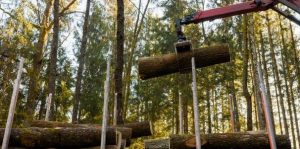 By Jim Girvan
By Jim Girvan
From Fall 2024 Truck Loggers Association Magazine
BRITISH COLUMBIA – Forestry, by its nature, is a slow moving, long-term game. Timber supply models used to set the allocated an-nual cut (AAC) are based on a 200-year planning cycle. Today’s harvest planning and cutting permit cycles can take years to complete. Free-to-grow silviculture ground rules can take 10-15 years de-pending on the site, and the harvest of a second rotation crop of trees can take 80 years or more.
While many of the daily activities we all deal with in this business can take years to accomplish, it doesn’t mean things move slowly when it comes to in-dustry reaction to forest policy change.
Looking back prior to 2000, the pre-mountain pine beetle (MPB) epidemic era, we saw an AAC of about 52 million cubic metres in BC with a typical annual harvest of about 50 million cubic metres (or about 98 per cent of the AAC). Saw-log supply was generally in balance with demand and industry employment was estimated to be 186,000.
The MPB epidemic erupted in 2000 and by 2006 it had killed a significant vol-ume of mature pine in the Interior. The government acted (surprisingly) quickly and by 2011 the provincial AAC in-creased to about 86 million cubic metres annually with a high of 87.3 million cu-bic metres in 2007. Industry reacted just as quickly and capacity at many Interior mills was increased to take advantage of the increased log supply.
However, the advent of the MPB epi-demic coincided with the global eco-nomic recession where the economics of the industry resulted in the closure of many lower quartile mills in BC. By 2011, 22 Interior sawmills or veneer plants had closed along with four sawmills on the Coast. Despite these challenges, during this period, the harvest averaged about 65 million cubic metres annually (about 76 per cent of the average AAC) and an average of 13.8 billion board feet of lum-ber was produced annually.
Once the MPB epidemic had peaked and salvage efforts wound down, govern-ment reduced the AAC and again, the in-dustry quickly took steps to further rationalize consumption seeing that their log supply was diminishing. By 2019, 16 more Interior sawmills and one coastal sawmill had closed. Despite the drop in AAC, the average annual harvest rose to 76 million cubic metres annually (76 per cent of the average AAC) with lumber production down to 12.2 billion board feet. However, as of 2015, employment was also down to 134,000 as the increased use of technol-ogy and mill closures displaced workers.
In late 2019, a forest policy shift started with the introduction of “A New Future for Old Forests” report. Shortly after its release, government implemented rec-ommendation 6 of the report; “to defer development in old forests where ecosys-tems are at very high and near-term risk of irreversible biodiversity loss”. This re-sulted in the deferral of harvest across 2.6 million hectares.
Industry reacted swiftly again as the roadmap for the BC forest industry sud-denly became clouded by the prospects of new forest policy that favoured pro-tection and conservation ahead of the needs of the industry and its employees.
Beyond forest deferrals, additional conservation oriented policy including caribou habitat conservation, the fed-eral and provincial 30 by 30 initiative, introduction of forest landscape plan-ning, the BC government’s $300 million Conservation Financing Mechanism and Tripartite Framework Agreement on Nature Conservation, spotted owl hab-itat conservation, the BC Biodiversity and Ecosystem Health Framework (draft), pending Land Act amendments and the Great Bear Rainforest Land Use Objectives Order (2023), all sent a clear signal to industry that the government was taking a new approach in BC’s forests and that log supply was not to be taken for granted.
Not surprisingly, industry again re-acted quickly. By 2023, six more sawmills had closed in the Interior and three ad-ditional mills have eliminated shifts. On the coast, four mills closed (for a total of 56 impacted mills since 2005). Beyond sawmill closures, a number of pulp, pa-per, pellet and power facilities across BC had closed as well.
While the average AAC since 2019 was only down to 66 million cubic metres (with a low of 62 million in 2023), the harvest had fallen to just 64 per cent of the AAC or just 46 million cubic metres (with a low harvest of 35 million cubic metres in 2023) given rising costs and lack of log supply. Since 2019, lumber production has averaged just 8.3 billion board feet per year, down 45 per cent from the peak in 2005.
Despite these clear moves towards forest conservation, government is also trying to encourage new investment in value-added manufacturing while the industry is drowning in high costs and a lack of wood supply.
And, as the harvest and lumber pro-duction fell, so did jobs. For 2022, COFI reported just 100,000 direct, indirect, and induced jobs (down 25 per cent) as being dependent on the forest industry. Since 2019 and the start of the forest pol-icy shift, two more sawmills have closed, Canfor announced it is closing its Plateau and Fort St. John operations, postponed a rebuild at Houston and closed one line at the Northwood pulp mill.
As Russ Taylor stated in the Summer 2024 issue of Truck LoggerBC magazine, “the NDP have made the BC forest in-dustry un-investable.”
Looking forward, the industry situ-ation isn’t any better. While the market forecast for W-SPF 2×4 #2&Better and better shows a continued upward trend in price, it will not likely be until 2026 when market prices will be consistently above break-even at which time remain-ing sawmills may be able to operate at full capacity, if logs are available via permits.
However, in a recent TLA study (out-lined in the chart), the collective impacts of the BC government’s various for-est policy initiatives will only continue the downward trend in both AAC and harvest. In summary, the study shows a decline in the 2024 AAC of 61.7 million cubic metres to 37.7 million cubic metres by 2035, a further 39 per cent reduction.
Policy impacts are forecast to reduce the Interior sawmill demand by 14 million cu-bic metres (to an average of 26.4 million cubic metres) when compared to the postrecession
(2010-2019) average harvest of 40 million cubic metres. The 2024 Coast AAC is forecast to fall from 15.4 million cubic metres to 10.4 million cubic metres or a 32 per cent reduction.
The projected decrease in AAC is likely to lead to the closure of three additional Interior sawmills and three coastal sawmills along with additional pulp/paper, pellet plant and power plant facility closures.
The forecast for a reduced BC harvest of 16 million cubic metres (compared to post-recession average harvest) would result in total job losses of over 34,000, and lumber production is forecast to average a mere 7.7 billion board feet annually, or 55 per cent of the peak production in the period between 2004-2011.
It is hard to imagine continued investment in the forest industry, let alone new investment in value added with such a significant loss of its primary raw material. Demand for wood fibre and especially coniferous sawlogs must always be in a relative balance with forecast supply. When they are not, changes in demand result and history has shown that these types
of changes happen quickly in an industry that otherwise looks to the long-term.
With a forecast of a continued reduction in the AAC due to adversarial forest policy, BC employment in the forest industry is forecast to fall to a mere 66,000; a 64.52 per cent decline in 20+ years.
Is this the future the BC government envisioned when their policy shift to forest protection and conservation began? Did they know that these policies would create an environment of uncertainty that would scare investment away rather than attract it?
Were they aware that losses of literally billions of dollars in GDP contributions to the Province is a direct result of the forest industry revenues falling by an harvest decline? And what about the loss of 34,000 rural, community-based forest industry jobs and all the taxes they will no longer pay? It all adds up to a lot of teachers, doctors, nurses and transit funding that the province can no longer afford to pay for. Is it any wonder rural emergency rooms periodically close and schools are overcrowded?
It is hard to believe government did not understand the consequences of their actions given the plethora of analy-sis and forecasting that has been made available to them since they began im-plementing policy initiatives to appease other demographic groups at the ex-pense of rural BC workers.
Can the path we are on change? Per-haps, but it will require that political leaders realize the problems and dem-onstrate a willingness to tackle them de-cisively with all interests, including the forest sector.


